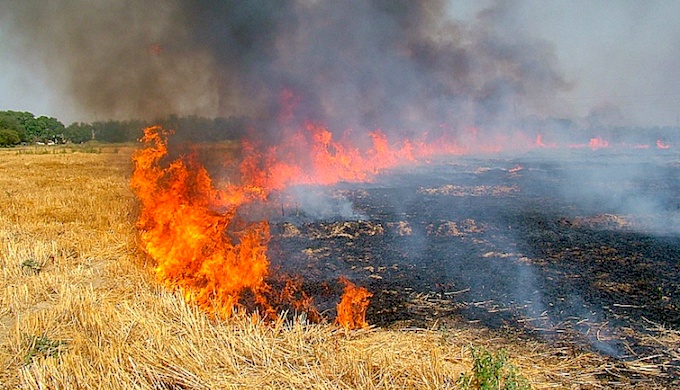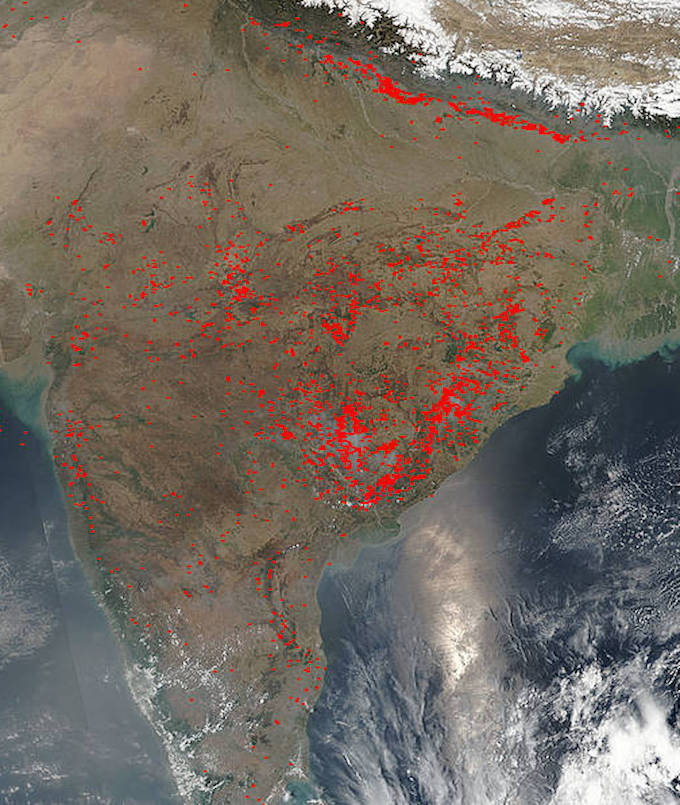Latest satellite images released by NASA show widespread burning of crop residue across India that is releasing an enormous amount of noxious carbon dioxide in the air over the southern Asian landmass

Burning of crop residues is a hazardous annual practice in India. (Photo by Manfred Sommer)
Even as India attempts to grapple with increasing air pollution in its cities, fires started by farmers across the country on crop residues are adding massively to the overall carbon dioxide load over South Asia. There are agricultural fires currently raging across the entire southern Asian landscape, according to the latest satellite image released by the National Aeronautics and Space Administration (NASA).
The image was taken by the Suomi NPP satellites’ VIIRS (Visible Infrared Imaging Radiometer Suite) instrument last week. The Suomi NPP satellite is a joint mission between NASA and National Oceanic and Atmospheric Administration (NOAA) of the US.
The location, widespread nature, and number of fires suggest that these fires were deliberately set to manage land, NASA said. Farmers often use fire to return nutrients to the soil and to clear the ground of unwanted plants. It is the most economical way to clear fields. While fire helps enhance crops and grasses for pasture, the fires also produce smoke that degrades air quality.

A satellite image of agricultural fires raging across India. (Photo by Jeff Schmaltz / NASA)
Each hot spot, which appears as a red mark, is an area where the thermal detectors on the MODIS instrument recognised temperatures higher than the background. When accompanied by plumes of smoke, such hot spots indicate fire. The smoke released these fires is a mixture of particles and chemicals produced by the incomplete burning of carbon-containing materials. All smoke contains carbon monoxide, carbon dioxide and particulate matter or soot.
Post-harvest fires
These farm fires occur twice a year in India, after the autumn and spring harvests. Last year, India’s capital New Delhi was enveloped in a thick haze that was partially due to widespread burning of straw left over from the rice harvest in Punjab and Haryana. On October 31, levels of particulate matter less that 2.5 microns reached around 700 micrograms per cubic metre in Delhi, more than 10 times the healthy limit, according to the Delhi Pollution Control Committee. PM2.5, or extremely fine particulate matter, is dangerous to human health because the particles can penetrate deep into people’s lungs and bloodstream.
India produces some 550 million tonnes of crop residue every year, with Uttar Pradesh, Punjab and Haryana being the highest producers, according to a report in the Hindustan Times. A 2012 study estimated that Punjab and Haryana burnt about 80% of rice residue, while Uttar Pradesh burnt 25% of it, the newspaper reported.
Air pollution in Indian cities is rising at an alarming rate and the high concentration of pollutants harm human health and hasten climate change, according to the World Health Organisation. Indian cities have some of the highest concentrations of particulate pollution, with as many as 14 cities among the worst 30, according to a Bloomberg report. Increasing air pollution in many of these cities is driving up the risk of stroke, heart disease and lung cancer in some of the most-vulnerable populations, the news agency said. See: Air pollution in India sees hazardous rise
Exposure to high levels of smoke is detrimental to health. Individuals with cardiovascular or respiratory conditions, foetuses, infants, young children, and the elderly may be more vulnerable to the health effects of smoke exposure. Also, this smoke tends to rise into the jet stream, allowing the smoke to travel long distances and cause smog in areas thousands of kilometres from the initial burning.
In November last year a report, Breathing Cleaner Air, by a task force of international experts recommended that the government needs to back a 10-point plan to improve air quality. This task force was formed after New Delhi was smothered under unprecedented smog on November 6 last year, and an emergency was declared as toxic pollutants reached severe levels. See: India needs to implement new plan to tackle air pollution
